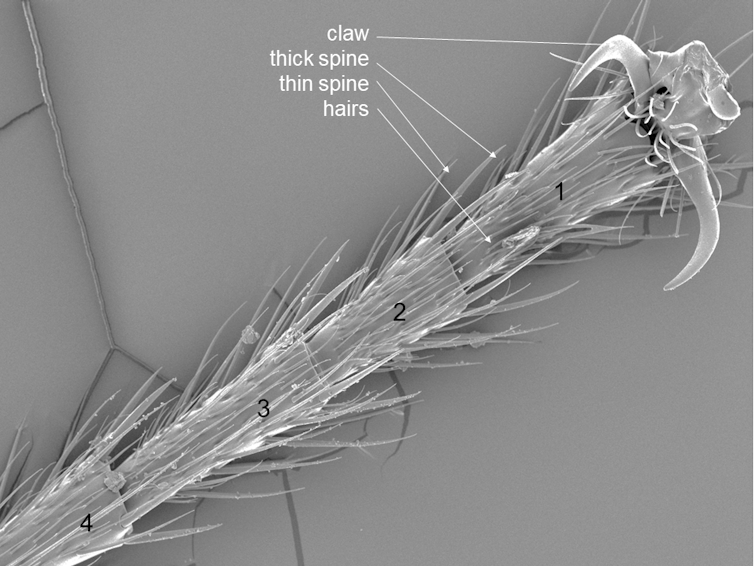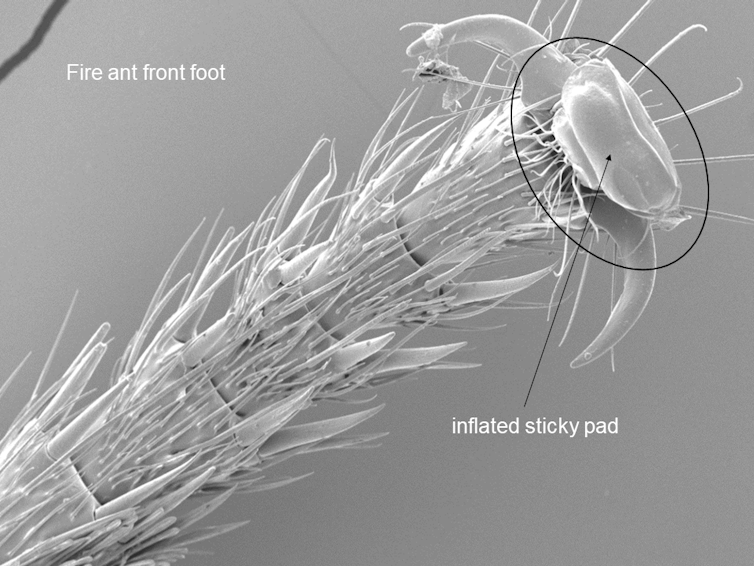When I first started my job as a biologist at the University of South Florida, I drove my Jeep to a grassy field, dug up a mound of fire ants and shoveled it into a 5-gallon bucket. Immediately, thousands of ants swarmed out of the soil and up the walls of the bucket headed for freedom. Luckily I had a lid.
How do ants make climbing walls, ceilings and other surfaces look so easy? I’ve been studying ants for 30 years, and their climbing abilities never cease to amaze me.
Worker ants – who are all female – have an impressive toolbox of claws, spines, hairs and sticky pads on their feet that enable them to scale almost any surface.
Human hands vs. ant feet
To understand ant feet, it helps to compare them with human hands. Your hand has one broad segment, the palm. Sprouting from your palm are four fingers and an opposable thumb. Each finger has three segments, while your thumb has only two segments. A hard nail grows from the tips of your fingers and thumb.
Humans have two hands – ants have six feet. Ant feet are similar to your hands but are more complex, with an additional set of weird-looking parts that enhance them.

Ant feet have five jointed segments, with the end segment sporting a pair of claws. The claws are shaped like a cat’s and can grip irregularities on walls. Each foot segment also has thick and thin spines and hairs that provide additional traction by sticking into microscopic pits on textured surfaces like bark. Claws and spines have the added benefit of protecting ant feet from hot pavement and sharp objects, just as your feet are protected by shoes.
But the feature that truly separates human hands from ant feet are inflatable sticky pads, called arolia.
Sticky feet
Arolia are located between the claws at the tip of every ant foot. These balloonlike pads allow ants to defy gravity and crawl on ceilings or ultrahard surfaces like glass.

When an ant walks up a wall or across a ceiling, gravity causes its claws to swing wide and pull back. At the same time, its leg muscles pump fluids into the pads at the end of its feet, causing them to inflate. This body fluid is called hemolymph, which is a sticky fluid similar to your blood that circulates throughout an ant’s body.
After the hemolymph pumps up the pad, some of it leaks outside the pad, which is how ants can stick to a wall or a ceiling. But when an ant picks up its foot, its leg muscles contract and suck most of the fluid back into the pad and then back up the leg. This way an ant’s blood is reused over and over – pumped from the leg into the pad, then sucked back up the leg – so none is left behind.

Ants are feather-light, so six sticky pads are enough to hold them against the pull of gravity on any surface. In fact, at home in their underground chambers, ants use their sticky pads to sleep on the ceiling. By sleeping on the ceiling, ants avoid the rush-hour traffic of other ants on the chamber floors.
A unique gait
When you walk, your left and right feet alternate so one is on the ground while the other is in the air, moving forward. Ants also alternate their feet, with three on the surface and three in the air at a time.
The walking pattern of ants is unique among six-legged insects. In ants, the front and back left feet are on the ground with the middle right foot, while the front and back right feet and the middle left foot are in the air. Then they switch. It’s fun to try to copy this triangular pattern using three fingers on each hand.
The next time you see an ant crawling up a wall, look closely and you might witness some of these fascinating features at work.
Hello, curious kids! Do you have a question you’d like an expert to answer? Ask an adult to send your question to CuriousKidsUS@theconversation.com. Please tell us your name, age and the city where you live.
And since curiosity has no age limit – adults, let us know what you’re wondering, too. We won’t be able to answer every question, but we will do our best.![]()
Deby Cassill, Associate Professor of Integrative Biology, University of South Florida
This article is republished from The Conversation under a Creative Commons license. Read the original article.










